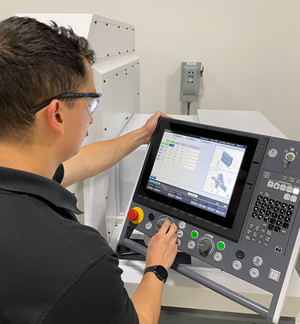Desktop 3D Scanner Captures Part Shapes
This desktop laser scanning system allows 3D objects to be digitized so that the data can be used to create part geometry for tool path generation. The system's ease of use and low cost make reverse engineering available to machine shops that could not previously access this technology.
Share





Scan it. Cut it. ThatŌĆÖs the approach many shops would like to take. A new desktop laser scanning system promises to make that a practical reality at low cost. The system allows 3D objects to be digitized so that surface data can be used to create part geometry for toolpath generation. The NextEngine Desktop 3D Scanner from NextEngine Inc. (Santa Monica, California) uses a set of laser ŌĆ£eyes,ŌĆØ digital camera technology and image sensors to capture scan data from multiple, triangulated views. The systemŌĆÖs special software assembles and manipulates the data to create a 3D model suitable for use in a CAM system.
Scanning systems for reverse engineering have been available for years. What sets this new system apart from existing systems is that it is priced and packaged like a consumer electronics product. The hardware consists of a scanning unit (about the size of a cereal box) and a turntable that automates part positioning for scanning. The user interface software, ScanStudio Core, operates the scanner and the turntable. It is priced at $2,495. Two software options, ScanStudio Pro and RapidWorks, provide further capabilities and are priced in the same range.
For the machine shop, desktop scanning is a benefit when the machining process starts with a partŌĆöa prototype, a pattern, a model or a free-form ŌĆ£organicŌĆØ shape carved in the studio or found in nature. CNC machines are designed to produce parts as the end product. The physical object cut from metal is the output. But CNC machines also require input, the numerical part program that gives the proper commands. Digital laser scanning helps bridge the gap from ŌĆ£start partŌĆØ to end part by providing the ŌĆ£artŌĆØ (shape geometry) in the middle. According to developers, the desktop scanner makes 3D scanning technology available to virtually any machine shop.
The scanning unit uses arrays of low-power lasers that sweep across an object while 3-megapixel cameras capture scanned data. Multiple sweeps and multiple positionings of the object are usually required to gather a complete 3D scan. The various passes can be displayed and merged in the PC software. Objects with matte white surfaces are easiest to scan; objects with shiny black surfaces are more difficult. The latter may require a powder dusting to reduce reflectiveness.
Objects the size of a soda can or smaller can be scanned in the ŌĆ£macro mode,ŌĆØ while objects as large as a shoebox can be scanned in the ŌĆ£wide mode.ŌĆØ The roundtable can be used to index smaller objects automatically for multiple scans. Large objects may have to be repositioned by hand. Developers say that, theoretically, there is no limit to the size of the object because any number of scans can be stitched together. Parts fitting within the "wide mode" can be scanned and aligned with one click. Scans from larger parts are semi-automatically aligned with ŌĆ£virtual beadsŌĆØ that the software can use to locate and connect common points in the scanned data for merging. Regardless of the merging process, blending and trimming overlaps is automated, thus speeding what might otherwise be a tedious process.
Scan data can be used to create file formats in three categoriesŌĆömesh, surface and solidŌĆöthat correspond to the level of software acquired by the user. For example, the standard software that comes with the system is adequate for STL formats that can be exported to a CAM system for basic machining. Most shops will be interested in the surface or solid file capabilities because they provide geometry comparable to the models shops often use as input to CAM.
Related Content
Continuous Improvement and New Functionality Are the Name of the Game
Mastercam 2025 incorporates big advancements and small — all based on customer feedback and the company’s commitment to keeping its signature product best in class.
Read MoreSwiss-Type Control Uses CNC Data to Improve Efficiency
Advanced controls for Swiss-type CNC lathes uses machine data to prevent tool collisions, saving setup time and scrap costs.
Read MoreSetting Up the Building Blocks for a Digital Factory
Woodward Inc. spent over a year developing an API to connect machines to its digital factory. Caron Engineering’s MiConnect has cut most of this process while also granting the shop greater access to machine information.
Read More4 Commonly Misapplied CNC Features
Misapplication of these important CNC features will result in wasted time, wasted or duplicated effort and/or wasted material.
Read MoreRead Next
AMRs Are Moving Into Manufacturing: 4 Considerations for Implementation
AMRs can provide a flexible, easy-to-use automation platform so long as manufacturers choose a suitable task and prepare their facilities.
Read MoreMachine Shop MBA
Making Chips and 91╩ėŲĄ═°šŠ╬█ are teaming up for a new podcast series called Machine Shop MBA—designed to help manufacturers measure their success against the industry’s best. Through the lens of the Top Shops benchmarking program, the series explores the KPIs that set high-performing shops apart, from machine utilization and first-pass yield to employee engagement and revenue per employee.
Read MoreLast Chance! 2025 Top Shops Benchmarking Survey Still Open Through April 30
Don’t miss out! 91╩ėŲĄ═°šŠ╬█'s Top Shops Benchmarking Survey is still open — but not for long. This is your last chance to a receive free, customized benchmarking report that includes actionable feedback across several shopfloor and business metrics.
Read More






















